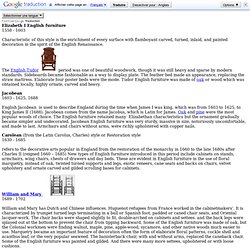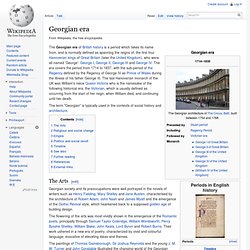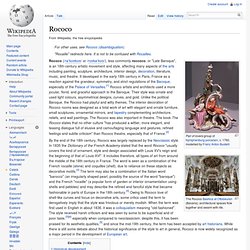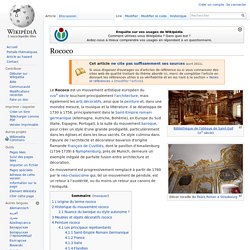

Rococo. Ci-contre: Jean-Honoré Fragonard - "Le verrou" (vers 1778), Le Louvre à Paris Le Rococo se développa en France, d'où son influence rayonna, au 18ème siècle, dans la plupart des autres pays d'Europe.

Ce style est dérivé de l'appellation «rocaille», qui désignait un style ornemental se démarquant nettement de la rigueur classique par des effets déchiquetés et asymétriques s'inspirant des caprices de la nature. L'art rococo se voulut essentiellement léger et foisonnant, un ton insouciant qui l’oppose au baroque dramatique et théâtral et reflète l’éclat d’une société finissante. Considéré naguère comme un art décadent, puis comme la phase finale du baroque, le rococo acquiert aujourd’hui le statut de style autonome. Antique Rococo Furniture. What is Rococo. Rococo. English Furniture Style Guide. English furniture style periods. Fourni par Traduction Elizabeth I English furniture 1558 - 1603 Characteristic of this style is the enrichment of every surface with flamboyant carved, turned, inlaid, and painted decoration in the spirit of the English Renaissance.

The English Tudor period was one of beautiful woodwork, though it was still heavy and sparse by modern standards. Jacobean 1603 - 1625, 1688 English Jacobean is used to describe England during the time when James I was king, which was from 1603 to 1625, to King James II (1688). Carolean (from the Latin Carolus, Charles) style or Restoration style 1630 - 1685 refers to the decorative arts popular in England from the restoration of the monarchy in 1660 to the late 1680s after Charles II (reigned 1660 – 1685) New types of English furniture introduced in this period include cabinets on stands, armchairs, wing chairs, chests of drawers and day beds. William and Mary William and Mary has Dutch and Chinese influences. The Queen Anne style English furniture Georgian. Georgian era. The Georgian era of British history is a period which takes its name from, and is normally defined as spanning the reigns of, the first four Hanoverian kings of Great Britain (later the United Kingdom), who were all named 'George': George I, George II, George III and George IV.

The era covers the period from 1714 to 1837, with the sub-period of the Regency defined by the Regency of George IV as Prince of Wales during the illness of his father George III. The last Hanoverian monarch of the UK was William's niece Queen Victoria who is the namesake of the following historical era, the Victorian, which is usually defined as occurring from the start of her reign, when William died, and continuing until her death. The term "Georgian" is typically used in the contexts of social history and architecture. The Arts[edit] The paintings of Thomas Gainsborough, Sir Joshua Reynolds and the young J. Religious and social change[edit] Empire[edit] Politics and social revolt[edit] Timeline[edit]
TripAdvisor. Rococo. Rococo (/rəˈkoʊkoʊ/ or /roʊkəˈkoʊ/), less commonly roccoco, or "Late Baroque", is an 18th-century artistic movement and style, affecting many aspects of the arts including painting, sculpture, architecture, interior design, decoration, literature, music, and theatre.

It developed in the early 18th century in Paris, France as a reaction against the grandeur, symmetry, and strict regulations of the Baroque, especially of the Palace of Versailles.[1] Rococo artists and architects used a more jocular, florid, and graceful approach to the Baroque. Rococo. Un article de Wikipédia, l'encyclopédie libre.

Le Rococo est un mouvement artistique européen du XVIIIe siècle touchant principalement l’architecture, mais également les arts décoratifs, ainsi que la peinture et, dans une moindre mesure, la musique et la littérature. Il se développa de 1730 à 1758, principalement dans le Saint-Empire romain germanique (Allemagne, Autriche, Bohême), en Europe du Sud (Italie, Espagne, Portugal), à la suite du mouvement baroque, pour créer un style d'une grande prodigalité, particulièrement dans les églises et dans les lieux sacrés.
Ce style culmina dans l'œuvre de l'architecte et décorateur bavarois d'origine flamande François de Cuvilliés, dont le pavillon d'Amalienburg (1734-1739) à Nymphenburg, près de Munich, demeure un exemple inégalé de parfaite fusion entre architecture et décoration. §L’origine du terme rococo[modifier | modifier le code] §Historique du mouvement rococo[modifier | modifier le code]